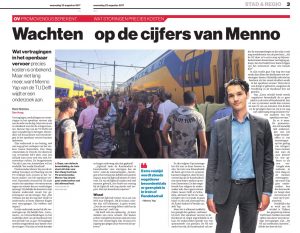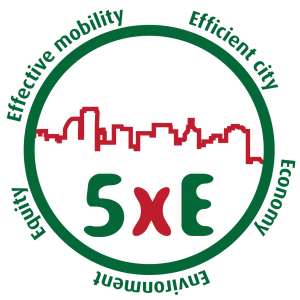Posted in August 2017
Inzicht in kosten van vertragingen
Menno Yap, PhD student in het TRANS-FORM project, vertelt over zijn onderzoek in het AD:

Urban Demand Responsive Transport in the Mobility as a Service ecosystem: its role and potential market share
Mobility as a Service (MaaS) is entering the transportation market. MaaS aims at the full
integration of the existing transportation services and it offers tailored mobility packages to
the user. In MaaS ecosystems, on-demand services play an important role as complement to
public transport due to their flexibility. However, to date, most attention has been placed on
individual on-demand services. This study focuses on Demand Responsive Transport (DRT):
collective on-demand services. Using an on-line survey, we analysed the characteristics of
the respondents who chose different modes of transport among their selected modes.
Results find a distinctive pattern in the willingness of users to use different modes, with
different levels in what could be considered as a multimodality ladder. The different rungs of
it would be: 1st car (if available), 2nd public transport, 3rd DRT and 4th taxi-like services.
This way, a person standing on the third rung would include car, public transport and DRT in
their consideration set, but not taxi. This finding suggests that, if implemented in the right
way, DRT services can attract a larger number of users than taxi-like services, especially in a
MaaS ecosystem where initial barriers to try this service can be lessened.
Find the paper presented by Maria Alonso Gonzalez at the Thredbo conference in Stockholm HERE
The wider benefits of high quality public transport for cities
The true value of public transport is often underestimated systematically while assessing transit impacts of proposed projects. During the planning and assessment of new or improved connections, infrastructure or services, often only the costs of operations, construction and the revenues with regard to fares and travel time savings are accounted for. This approach provides insights into the performance of public transport to some extent, but disregards many other (positive) effects the provision of public services has. Many of which impose an advantage over competing modes of transport. This could result in the postponement or even cancellation of plans, as means are scarce and invested where gains are directly visible. Thus, to enable a fairer assessment of public transport plans, more insight is required into the wider benefits of its operations and impacts on passengers and the environment.
To gain these insights, we developed a methodology to quantify the value of public transport using the five E’s: Effective mobility, Efficient city, Economy, Environment and Equity. Together these aspects provide a better indication of all potential benefits of public transport.
Read more in this ETC 2017 conference paper.

Understanding the trip and user characteristics of the combined bicycle and transit mode
Several cities around the world are facing mobility related problems such as traffic congestion and air pollution. Although limited individually, the combination of bicycle and transit offers speed and accessibility; by complementing each other’s characteristics the bicycle and transit combination can compete with automobiles. Recognising this, several studies have investigated policies that encourage integration of these modes. However, empirical analysis of the actual users and trips of the combined mode is largely missing. This study addresses this gap by (i) reviewing empirical findings on related modes, (ii) deriving user and trip characteristics of the bicycle and transit mode in the Netherlands, and (iii) applying latent class cluster analysis to discover prototypical users based on their socio-demographic attributes. Most trips by this mode are found to be for relatively long commutes where transit is in the form of trains, and bicycle and walking are access and egress modes respectively. Furthermore, seven user groups are identified and their spatial and temporal travel behaviour is discussed. Transport authorities may use the empirical results in this study to further streamline integration of bicycle and transit for its largest users as well as to tailor policies to attract more travellers.
Find our Thredbo conference presentation HERE
Read our paper HERE
